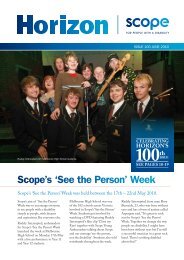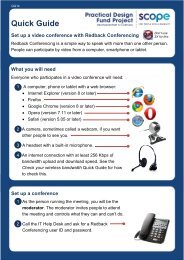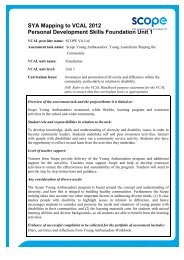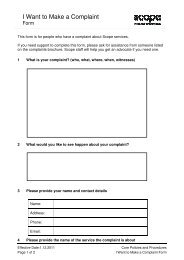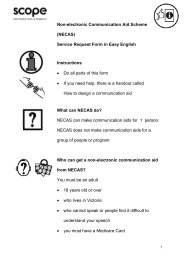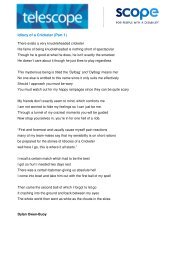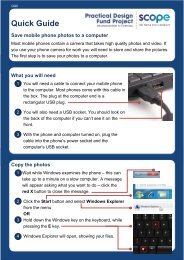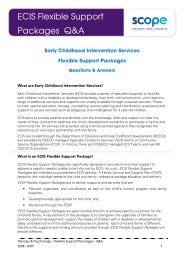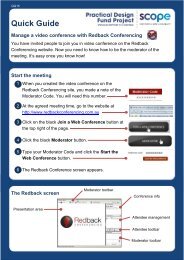Positive behaviour support Getting it right from the start
Positive behaviour support Getting it right from the start
Positive behaviour support Getting it right from the start
Create successful ePaper yourself
Turn your PDF publications into a flip-book with our unique Google optimized e-Paper software.
<strong>Pos<strong>it</strong>ive</strong> <strong>behaviour</strong> <strong>support</strong>: <strong>Getting</strong> <strong>it</strong> <strong>right</strong> <strong>from</strong> <strong>the</strong> <strong>start</strong> - Facil<strong>it</strong>ators reference manual 47<br />
PowerPoint 67<br />
*<br />
The communication continuum<br />
Unintentional Intentional Intentional-symbolic Basic l<strong>it</strong>eracy<br />
Assessments<br />
to use<br />
Use Triple CCC to identify person’s communicative abil<strong>it</strong>y<br />
Do not use Triple<br />
CCC for people who<br />
have more than 50<br />
words or signs that<br />
<strong>the</strong>y can use to<br />
communicate. Refer<br />
to speech pathologist<br />
for a comprehensive<br />
assessment.<br />
Communication skills<br />
The person doesn’t<br />
use communication<br />
as a tool, to obtain a<br />
goal.<br />
Person has not<br />
yet developed<br />
<strong>the</strong> cogn<strong>it</strong>ive<br />
pre-requis<strong>it</strong>e skills<br />
for intentional<br />
communication.<br />
The person uses<br />
communication as a<br />
tool to obtain a goal,<br />
Person has developed<br />
<strong>the</strong> cogn<strong>it</strong>ive<br />
pre-requis<strong>it</strong>es for<br />
intentional, but means<br />
of communication<br />
are not easy to<br />
understand.<br />
The person uses<br />
formal symbol<br />
systems to<br />
communicate <strong>the</strong>ir<br />
message and obtain<br />
<strong>the</strong>ir goal.<br />
The person<br />
has effective<br />
communication<br />
skills w<strong>it</strong>h over 50<br />
words/signs in <strong>the</strong>ir<br />
vocabulary. Is able to<br />
read simple words or<br />
phrases.<br />
Example<br />
The person looks<br />
at a desired object<br />
but does not look at<br />
ano<strong>the</strong>r person. The<br />
person may cry/<br />
scream, laugh/smile<br />
w<strong>it</strong>h no apparent<br />
purpose.<br />
The person looks at<br />
or points to a desired<br />
object/activ<strong>it</strong>y while<br />
looking at a person in<br />
<strong>the</strong> room. The person<br />
may take someone’s<br />
hand and lead <strong>the</strong>m<br />
to a desired object/<br />
activ<strong>it</strong>y.<br />
The person uses<br />
photographs, line<br />
drawings, objects, to<br />
communicate <strong>the</strong>ir<br />
message.<br />
The person uses,<br />
photographs,<br />
line drawings, to<br />
communicate <strong>the</strong>ir<br />
message.<br />
Role of<br />
communication<br />
partner<br />
The communication<br />
partner assigns <strong>the</strong><br />
intent and meaning to<br />
<strong>the</strong> communication.<br />
The communication<br />
partner reads/<br />
interprets <strong>the</strong> intent<br />
and meaning and<br />
responds.<br />
The communication<br />
partner decodes<br />
<strong>the</strong> message and<br />
responds.<br />
Very important<br />
to identify<br />
areas to extend<br />
communication skills<br />
fur<strong>the</strong>r (e.g. social<br />
communication,<br />
feelings, l<strong>it</strong>eracy).<br />
PowerPoint 68<br />
*<br />
About <strong>the</strong> Checklist of Communication Competencies 11<br />
The Checklist of Communication Competencies is also known as <strong>the</strong> Triple C. It is an<br />
observational screening tool designed to ascertain <strong>the</strong> approximate stage at which a person<br />
is communicating and is designed for use w<strong>it</strong>h adolescents and adults who have complex<br />
communication needs. It is a useful tool for assessing early communication skills that act as<br />
building blocks for effective communication. The checklist can be filled in by anyone who knows<br />
<strong>the</strong> person well and often <strong>it</strong> is useful for different <strong>support</strong> professionals <strong>from</strong> <strong>the</strong> same and<br />
different environments to complete separate checklists and compare findings.<br />
11. Bloomberg K, & West, D (1999), The Triple C: Checklist of Communication Competencies.<br />
Triple C Copy<strong>right</strong> of SCIOP



